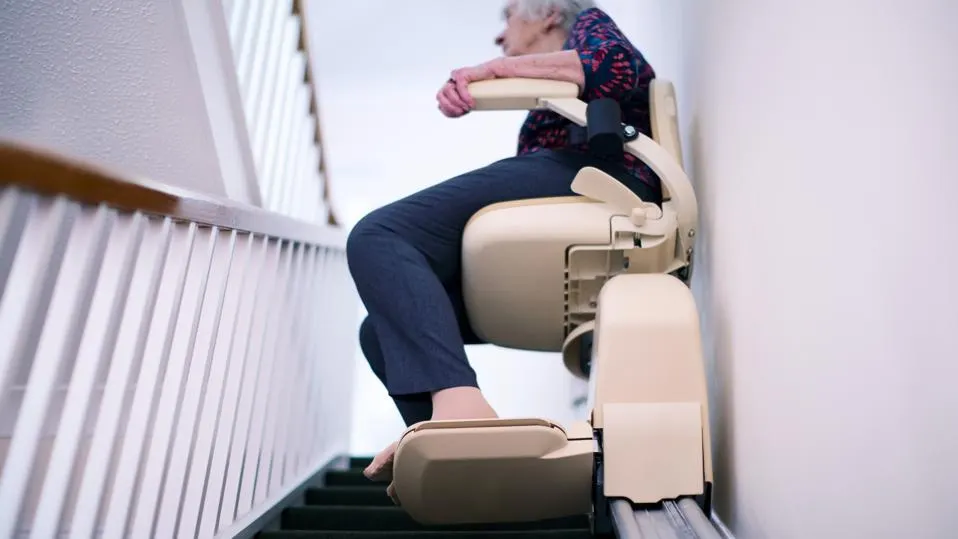There’s an old adage that states “age is just a number”. However, when you start experiencing mobility issues, that number weighs down on you. Mobility issues can occur at any age, and they can be caused by arthritis, a heart condition, an accident, and so on. The worst part is when you have to go up and down the stairs, on a regular basis, in your own home, and ask for assistance from family, friends, or a caregiver. Though they are happy to lend you a hand, what about when you’re alone? That’s where a stairlift comes in!
What is a StairLift?
A stairlift is a chair attached to the handrails that aid in carrying the elderly or disabled person up and down a flight of stairs. There are other types of homelifts available, including a home elevator and a wheelchair lift. It is crucial to buy a sturdy one, so be sure to check out trusted companies such as Homelift for reliable solutions.
While elevators and wheelchair lifts take space to build, stairlifts were built to save electricity and space. It is also motorized and can lift up and down a person weighing a maximum of 300 lbs.
Things To Know Before Installing a StairLift
Installing stairlifts can significantly enhance mobility and accessibility, but before making any decision, it is crucial to understand the factors when installing one in your home.
-
Determine Your Needs and Location
If you have stairs outside your home and/or inside, you need to consider where to install the stairlift. Do you want it to go in and out of the house or up and down the stairs?
The next part is where you decide on the type of lift to use. Whether you have a straight or a curved staircase, choose the one suitable for your home and for the person who is going to use it.
-
Assess your Space
Before investing in a stairlift, you need to determine the amount of space required and measure the dimensions of the staircase. This way, you’ll be able to install a perfect stairlift without blocking the entire staircase.
-
Understand the Features
Stairlifts have lots of features that you need to familiarize yourself with.
- Adjustable Height: An adjustable seat gives an ease of access and disembarkment, regardless of the individual’s height.
- Seat Rotation: For individuals with limited strength, for instance, the rotation of the seat makes it easy for them to get on and off from the stairlift to a wheelchair safely.
-
Safety Features:
- Stairlifts come with obstruction sensors which help to prevent conflicts and accidents from taking place.
-
- Built-in seatbelts are a key safety feature when safely operating a stairlift.
- Seat Lock determines when the seat is in the right position and locks it in before starting up the stairs.
-
Different types of controls:
- Joystick: This is where there is a little joystick control on the armrest to move the stairlift up and down. If there’s no pressure on the joystick, the stairlift will stop moving.
- Wall-mounted: This is easier as you won’t require applying continuous pressure on your hands. Just turn on the switch on the wall, at the top and the bottom of the stairs, after you get into the chair.
Find Out the Cost
The price of a stairlift varies according to its type, features, and complexity. You can prepare a budget to help finance a stairlift and also research other financing options, such as insurance coverage or grants that can offset the costs. Some manufacturers are giving it out on rent or have lease-to-own options.
Maintenance & Service Plans
Just like any other machinery, stairlifts also require regular maintenance and servicing to function optimally. Find out the comprehensive service plans from the manufacturing company or the installer. This plan can extend the life of your stairlift and continue its reliability.

Consult a Healthcare Professional
Ask for advice from your physician or your therapist when buying a stairlift. They can determine the best type of stairlift needed according to your condition and ensure it meets your requirements.
User-friendly
Whether you choose for yourself or for someone else, make sure the features of a stairlift are easy to understand and implement. That is, having easy-to-use controls, remote operation, and rotated motorized seats to get on and off seamlessly.
Comfort
Another important feature to consider is the comfort of the user. Factors such as size of the seat, seat padding, back support, and armrests should be considered carefully, especially if it’s a longer ride up and down the stairs.
Consider Installation Requirements
Installing a stairlift means modifying your staircase and maybe even your walls. Therefore, evaluate the necessary alterations that are required and make sure your house’s structural integrity is not compromised in the process. The installer will help you in this regard.
Another important factor that the installer might need to know is the type of flooring you use. Whether you use carpet, hardwood flooring, wooden or ceramic, or whether you intend to repair your flooring in the future, answering these questions helps the installers decide which stairlifts would be easier to install and use.
For safety and security purposes, use professionals to install a stairlift instead of trying it yourself or letting others do it for less money. Safety is a factor that should not be compromised.
In a Nutshell
For individuals with limited mobility, installing a stairlift can bring a significant difference to their everyday lives. So, therefore, consider your needs, discover various features, understand the installation procedures, and learn about maintenance plans to ensure using the stairlift for a long period. Consult a professional healthcare or a therapist to make sure you get the right stairlift suitable for you and your home. In addition, make sure it’s comfortable and user-friendly for you or someone you know as that’ll make the experience safer and easier.





